Dairy Enzyme Market Research, 2031
The global Dairy Enzyme Market Size was at $574.2 million in 2021, and is projected to reach $1.1 billion by 2031, growing at a CAGR of 6.4% from 2022 to 2031.
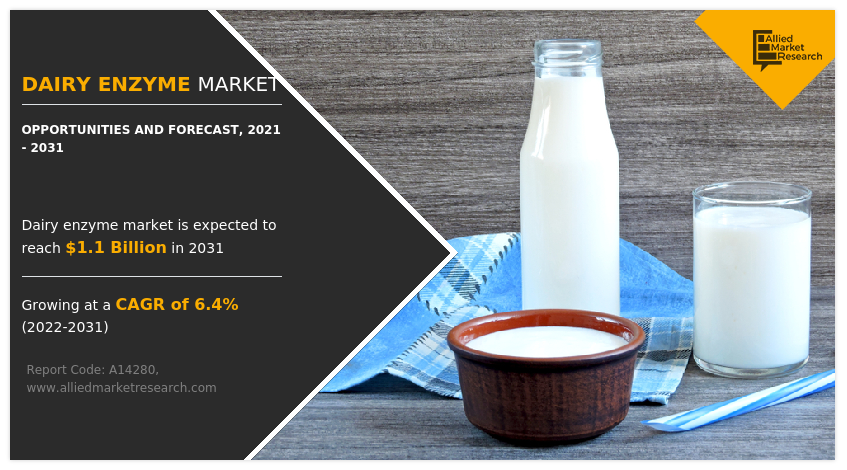
The dairy enzyme market is segmented into Type, Application and Source.
Dairy enzymes are complex ingredients, which act as catalyzers and are extensively used for increasing the diversity, variety, and quality during processing of dairy products. Dairy enzymes are often used for dairy processing owing to its multiple benefits, which include enhancement of texture, flavour & fragrance, preservation, coagulation, and tenderization. Dairy enzymes are generally produced through fermentation process. Both fed-batch and continuous fermentation processes are commonly used for the commercial production of dairy enzymes across the world; however, dairy enzymes are also sourced from animals and plants.
The world has seen exponential growth in number of dairy products processors. Equally impressive has been the growth in associated Dairy Enzyme Industry. Although dairy is a part of daily requisite, it is the convergence of clean label and health that has caused significant shifts in consumer awareness, outlook, and behavior. This changing landscape, in tandem with the upcoming trends and the growth trajectory in Dairy Enzyme Market Size that world is experiencing, is fast-tracking the growth of the dairy products industry. This pace of growth is expected to continue in the future, driven primarily by the consumer and dairy outlets operators. Till late twentieth century, Transglutaminase was commercially derived from the liver of guinea pigs. This source was very hard to find as it was very rarely available. This enzyme was not stable at different temperatures at that time. However, scientists found an innovative way to isolate the Transglutaminase enzyme through microorganisms. As compared to previous transglutaminase, this new enzyme is more stable at different temperatures and in PH values as well. This was later used as a dairy additive by dairy industries and for producing various dairy products.The global market of dairy enzymes has experienced growth in innovation during the last few years. Introduction of technologies such as cold–adapted Enzymes have revolutionized the Dairy Enzyme Market Growth. Novel innovation in found enzymes have resulted in invention of dairy enzymes operating at very low temperatures as well enzymes. These cold-adapted enzymes have a unique feature of being inactivate after performing their job at low temperatures. Cold-adapt have broad potential of uses. Cold-adapted enzymes are utilized in cheese processing, along with juice processing, and meat & meat products industry.
Dairy enzyme requires a specific temperature and pH range to operate, as enzymes are sensitive to changes that occur in temperature, pH, and concentration of substrates. Using the appropriate enzymes according to the process and application is the greatest challenge for R&D activities in dairy processing. Enzymes are classified according to the grades, namely analytical grades, pharmaceutical grades, and feed grades. Some of the associations have standardized the grade of enzymes such as Food Chemicals Codex (FCC) and FAO/WHO, Joint Expert Committee on Food Additives (JECFA), AMFEP of Europe and Enzyme Technical Association (ETA). These enzymes should be used by the standards given by these associations. Thus, such restricted nature of enzymes creates hurdles for the market growth.
Leading players in the global dairy enzymes market are providing customized solution to improve texture and flavors of dairy products. Leading manufacturers have introduced immobilized enzyme technology. This technology helps in increased resistance to changes in conditions such as temperature and pH. Immobilized enzyme technology provides benefits of convenience, low cost, and high stability. It can find its significant application in the dairy and brewing industry. However, additional cost of immobilized enzyme technology is expected to limit the market growth.
The global dairy enzymes market is segmented based on type, application, source, and region. Based on type, the dairy enzyme market is segmented into lipase, carbohydrase, protease, esterase, catalase, transglutaminase, and others. Based on application, the market is divided into milk, cheese, ice cream and desserts, yogurt, whey, infant formula. Based on source, the market is analyzed across microorganisms, animals, and plants. Based on region, the market is studied across North America, Europe, Asia-Pacific, and LAMEA.
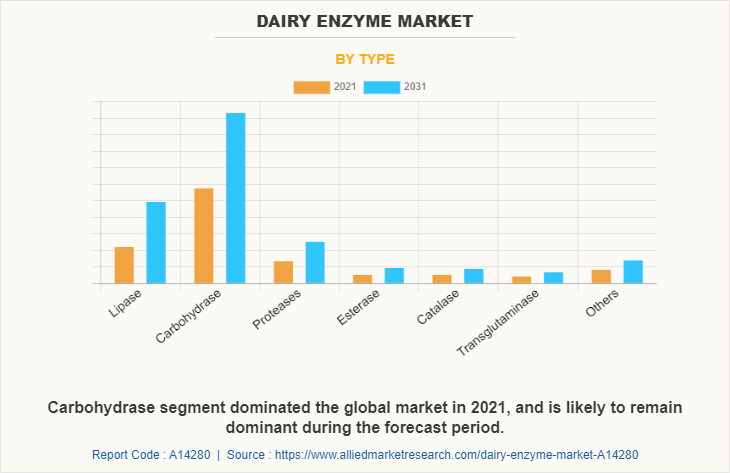
0n the basis of type, the dairy enzymes market is categorized into lipase, carbohydrase, protease, Esterase, catalase, transglutaminase, and others. The carbohydrase segment dominated the overall Dairy Enzyme Market Share in 2021 and is expected to remain dominant during the Dairy Enzyme Market Forecast. Carbohydrase enzyme is chiefly applicable in dairy and brewing industries, as it performs function of conversion of carbohydrates into simple sugar. The increasing demand for milk is the major driver for market growth. Also, the rising demand of ice cream, and flavored milk play vital role in increasing market growth. In addition, the introduction of new milk-based products and increase penetration of retails channel plays vital role in market growth.
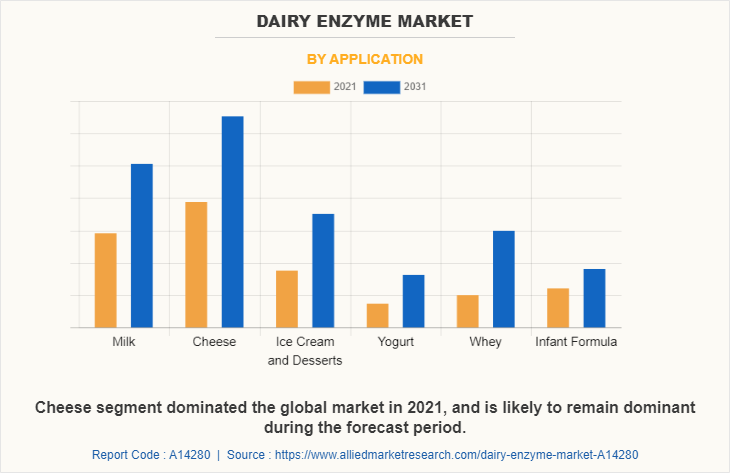
On the basis of application, market is segmented into milk, cheese, ice cream & desserts, yogurt, whey, and infant formula. The cheese segment was the highest revenue contributor to the market, owing to rise in cheese flavor, rise in disposable income, and increase in demand for protein rich food propel the market growth. The increasing consumers preference for testing the new exotic flavors and the cuisines couple with the increasing popularity for cheese flavor combination in various cuisines such as Mexican and Italian has accelerated the demand into the market. Also, the continuously expanding food service sector leading to the development of innovative products like flavored cheese is one of the emerging categories is expected to drive market. Also, the emerging trend for the handmade natural and the artisan cheese varieties is gaining popularity among the consumers, which is making positive impact to the market.
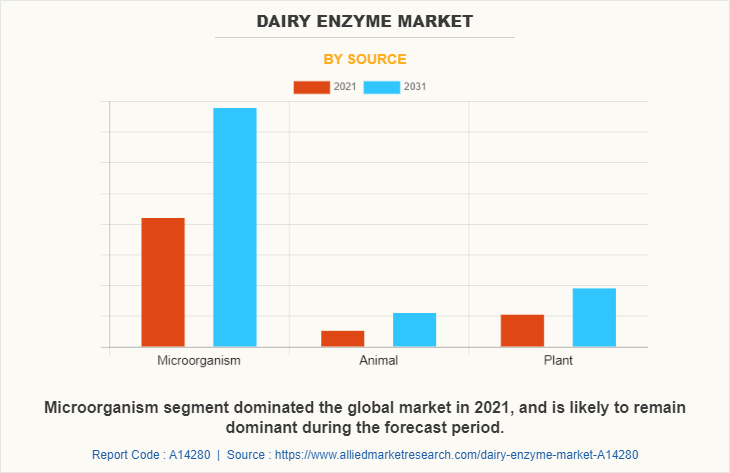
On the basis of source, the market is segmented into micro-organism, animal, and plant. The microorganism segment was the highest revenue contributor to the market, `owing to development of fermentation techniques for the production of microbial enzymes aid in providing extensive supply of enzymes. The production of enzymes from microorganisms follows a series of procedures that starts with the screening of microorganisms. The microorganisms that are used for the production of enzymes are grown and cultivated in a fermenter with the help of growth media. Furthermore, the screening and cultivation processes are followed by isolation and purification.Increasing uses of microbial enzymes for the development of milk and its related product is enhancing the functional properties in the dairy industry. Also, the increasing urbanization in developing economics and the rising purchasing power of the consumer having increase the demand for the process milk products. The increasing preference of manufacturers for animal and microorganism as a source of enzyme due to the simple extraction process and is also cost effective to develop dairy products.
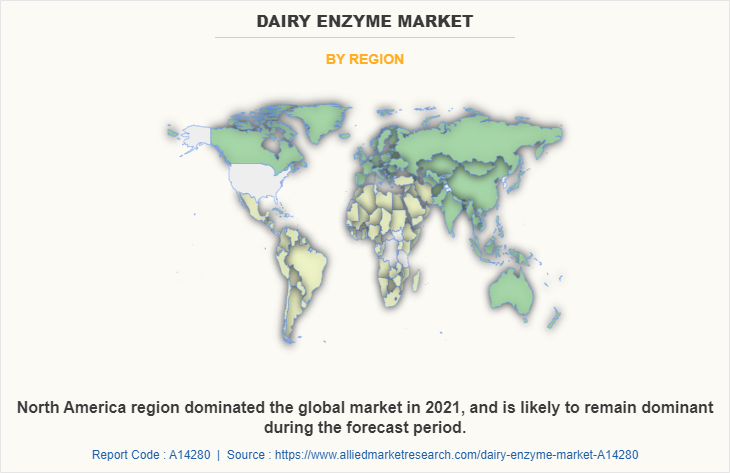
As per region, the Dairy Enzyme Market Share is analyzed across North America, Europe, Asia-Pacific, and LAMEA. North America is the leading consumer of dairy enzymes followed by Europe and Asia-Pacific. However, Asia-Pacific is poised to gain significant market share in the global dairy enzyme market during the forecast period. It is imperative to note that immobilized enzyme technology for dairy applications has gained high traction in the past few years. Immobilized enzyme technology enhances characteristics of dairy enzymes such as slow reaction rate, limited shelf life, and operational stability. The three major countries of North America considered in the report include the U.S., Canada, and Mexico. North America is the largest revenue contributor globally and is a mature market for dairy enzymes products. Early adoption of advanced technology in dairy industries and the introduction of the new enzyme are the key driving factors of the North American dairy enzymes market. An increase in the number of dairy processing industries accelerates the growth of the dairy enzymes market in this region. The advancements in enzyme formulation have helped in finding new applications of enzymes in dairy apart from their conventional use. Moreover, the rise in Dairy Enzyme Market Demandfor cold-adapted enzymes, the low production cost of enzymes, and high efficacy production boost the growth of the North American dairy enzymes market. The Europe corn hydrolysate market is studied across countries such as the UK, Italy, Germany, France, Spain, The Netherlands, Switzerland, and the Rest OF Europe. From a global perspective, Europe is considered as the prominent market for Dairy Enzyme Market . The rise in expenditure on R&D by engaged Dairy Enzyme Industry stakeholders in the dairy enzyme market fuel the growth of the dairy enzyme market in the region.An upsurge in demand for alcohol and bakery & dairy products in European countries is anticipated to create lucrative Dairy Enzyme Market Opportunity for players. In addition, trends of clean labeling have gained wide attraction across the region. Leading players are now venturing into this segment to cater to the growth in demand from health-conscious consumers. Innovation of flavors in dairy products along with nutritive value is expected to drive market growth.
Key Benefits For Stakeholders
- This report provides a quantitative analysis of the market segments, current trends, estimations, and dynamics of the dairy enzyme market analysis from 2021 to 2031 to identify the prevailing dairy enzyme market opportunities.
- The market research is offered along with information related to key drivers, restraints, and opportunities.
- Porter's five forces analysis highlights the potency of buyers and suppliers to enable stakeholders to make profit-oriented business decisions and strengthen their supplier-buyer network.
- In-depth analysis of the dairy enzyme market segmentation assists to determine the prevailing market opportunities.
- Major countries in each region are mapped according to their revenue contribution to the global market.
- Market player positioning facilitates benchmarking and provides a clear understanding of the present position of the market players.
- The report includes the analysis of the regional as well as global dairy enzyme market trends, key players, market segments, application areas, and market growth strategies.
Dairy Enzyme Market Report Highlights
| Aspects | Details |
| Market Size By 2031 | USD 1.1 billion |
| Growth Rate | CAGR of 6.4% |
| Forecast period | 2021 - 2031 |
| Report Pages | 330 |
| By Type |
|
| By Application |
|
| By Source |
|
| By Region |
|
| Key Market Players | Kerry Group Plc, Associated British Foods plc, Novozymes A/S, Biocatalysts, Koninklijke DSM N.V., BASF SE, Wilbur-Ellis Holdings, Inc., Amano Enzyme Inc., Chr. Hansen Holding A/S, Aumenzymes, DuPont de Nemours, Inc., Phythozymes, STERN-WYWIOL GRUPPE GMBH CO. KG, Advanced Enzyme Technologies, Infinita Biotech Private Limited |
Analyst Review
The dairy enzymes market remained one of the few bright spots in an otherwise troubled global economy. The market is expected to experience growth during the forecast period owing to the expansion of the dairy industry, diversification in the extraction process, and rise in the trend of cold-adapted enzymes. At the same time, the sector is facing challenges driven by certain dairy enzyme allergies, limited shelf life, and high sensitivity of dairy enzymes toward temperature and pH.
Based on the interviews of various top-level CXOs of the leading companies, engaged stakeholders in the industry are spending significant time and resources to create new applications for dairy enzymes and patent their innovations. Also, the manufacturers are adopting new strategies to expand their operations in the market which are new product launches and product innovations. The new product launches by manufacturers to fulfill the need of their customers and ensures better market coverage. Also, the increasing R&D efforts in the dairy enzyme industry is making a positive impact on the market. Furthermore, leading players are converging toward clean-label dairy enzymes to maintain their reputation by producing safe and high-quality natural products.
The global Dairy Enzyme Market Size was at $574.2 million in 2021, and is projected to reach $1.1 billion by 2031
The global Dairy Enzyme market is projected to grow at a compound annual growth rate of 6.4% from 2022 to 2031 $1.1 billion by 2031
Kerry Group Plc, Wilbur-Ellis Holdings, Inc., Infinita Biotech Private Limited, Associated British Foods plc, Chr. Hansen Holding A/S, Biocatalysts, Koninklijke DSM N.V., STERN-WYWIOL GRUPPE GMBH CO. KG, Phythozymes, Aumenzymes, Advanced Enzyme Technologies, DuPont de Nemours, Inc., Amano Enzyme Inc., BASF SE, Novozymes A/S
Asia-Pacific is poised to gain significant market share in the global dairy enzyme market during the forecast period
Increase in the standard of living Increase in the availability of customized solutions to improve texture and flavors of dairy products
Loading Table Of Content...



